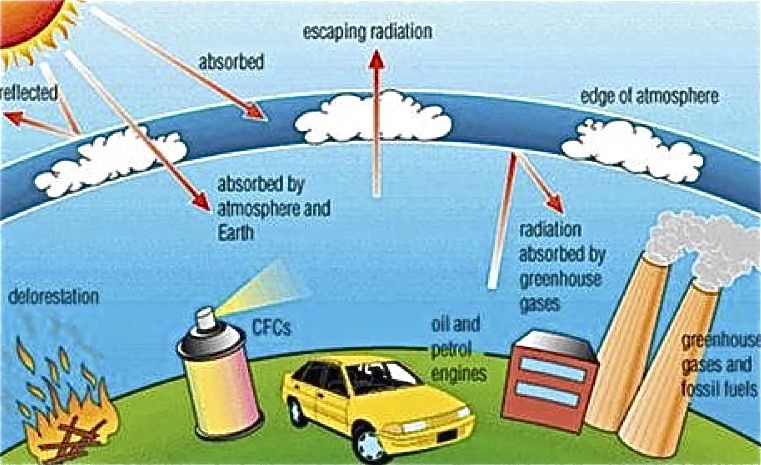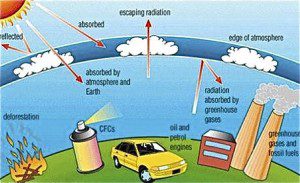
20 Apr EARTH MATTERS: EARTH’S ENERGY BALANCE
Editor’s Note: The dynamic duo of Billy Mason (who wrote this post) and Anna Zivian, scholars with an agenda to save our planet, posts weekly, stories about everything from what happened to bees to strawberries, the state of the ocean, and climate change. All of their stories are based on hard science. Science is based on facts. Sometimes the facts are hard to dumb down for the average Jane or Joe. This latest on climate change is geeky, but, as always, well worth challenging our brains to understand.
 The vast majority of nations in the world participate in the Kyoto Protocol designed to reduce human-induced greenhouse gases in the atmosphere that are responsible for global warming. However, a lack of awareness in the U.S. has resulted in confusion about the mechanics that cause climate change. Therefore, fostering an understanding of Earth’s energy balance and the relationship between the greenhouse effect and global warming should help Americans see through the fallacies of climate change deniers.
The vast majority of nations in the world participate in the Kyoto Protocol designed to reduce human-induced greenhouse gases in the atmosphere that are responsible for global warming. However, a lack of awareness in the U.S. has resulted in confusion about the mechanics that cause climate change. Therefore, fostering an understanding of Earth’s energy balance and the relationship between the greenhouse effect and global warming should help Americans see through the fallacies of climate change deniers.
The electromagnetic energy driving all of Earth’s atmospheric processes originates from solar radiation produced by the sun. The total amount of energy emitted from any object varies according to its temperature. For example, the Sun emits about 160,000 times more energy than the Earth because of its higher temperatures. Furthermore, not all objects emit wavelengths of energy in equal amounts. According to Wien’s law, hotter objects radiate peak intensity energy at shorter wavelengths than cooler objects. Thus, the sun emits proportionally more short wavelength energy than does the Earth. The amount of incoming solar radiation that reaches Earth’s upper atmosphere at approximately 74 miles above the Earth’s surface, known as the solar constant, remains relatively sustained at 1367 watts per square meter.
The function of the atmosphere is similar to the function of a reservoir. It holds a mixture of invisible gases, suspended microscopic solid particles, and water droplets that are exchanged by physical and biological processes between the atmosphere and Earth’s surface. The predominant atmospheric effects on in-coming solar radiation (insolation) include transmission and absorption of short wavelength radiation. Nearly half of the shortwave radiation that reaches the Earth’s surface by direct and diffuse transmission is absorbed and converted into long wavelength radiation. The majority of the long-wave radiation from the surface transfers directly into the lower atmosphere. A smaller portion conducts upward via a thin laminar boundary layer of air near the surface, and transforms into sensible heat, convective heat energy, and latent heat energy.
Sensible heat results from the addition of energy to a substance that causes a rise in temperature that we can physically feel. In contrast, convection takes place when sensible heat transforms, via conduction, into a liquid or gas and heat transfer occurs due to displacement of the medium. Whereas latent heat energy transpires when long wavelength radiation changes the phase of a solid, liquid, or gas substance. For example, the release of latent heat energy into the atmosphere during evaporation happens when water warmed at the surface changes from a liquid to a vapor gas. Furthermore, clouds, atmospheric gases, and particulate matter absorb about one-fifth of the short wavelength radiation from the sun and convert it into long wavelength radiation before releasing it back into the atmosphere.
In addition, approximately one-third of the insolation returns to space as a result of the planetary albedo effect caused by surface reflection, cloud reflection, and scattering by air molecules and airborne particulates. Radiation scattered in all directions by gas molecules, called Rayleigh scattering, creates the daytime sky’s appearance as blue. In contrast, Mie scattering of radiation in a forward-only direction by suspended aerosols causes the sky to appear grey, whereas nonselective scattering by water droplets, that act like a lens, induce clouds to appear white or grey, and a rainbow to appear to have a spectrum of colors. Over time, 69% of the insolation absorbed by the atmosphere and Earth’s surface radiates back into space and 31% reflects or scatters back into space. This equates to the total input of the solar radiation from the sun and constitutes Earth’s energy balance.
Greenhouse Effect:
Fortunately for life on Earth, greenhouse gases such as water vapor, CO2, methane (CH4), and nitrous oxide (N2O) absorb the majority of the long wavelength radiation and re-radiate it downward towards the surface in a process known as the Greenhouse Effect. Simply put, the Greenhouse Effect acts like a blanket above the Earth and warms the atmosphere. Without the Greenhouse Effect, the mean global temperature would radically swing between day and night. Additionally, annual average global temperatures near the surface would decrease from approximately 57°F to -64°F.
Unfortunately, as indicated in a previous article for Telluride Inside… and Out, “Climate Change is Real”, human-induced greenhouse gases have increased the concentration levels of CO2 in the atmosphere and upset Earth’s natural energy balance. As a result, the atmosphere is warming. Recent research by climatologists has theorized that if the primary greenhouse gas in the atmosphere, CO2, remains above 350 parts per million (ppm), global warming will cause significant climate change. As of March 2012, the concentration of CO2 in the atmosphere has risen to 394 ppm. Furthermore, the rate of change has been at its highest within the last 30 years. This rate of change happens to coincide with the global increase of human-induced CO2 emissions. According to the National Oceanic and Atmospheric Administration (NOAA), the U.S. surface air temperatures in March 2012 were the warmest in March since record keeping began 1895.
As a consequence of centuries of research, scientists empirically understand the relationship between Earth’s energy balance and the greenhouse effect that facilitates regulating Earth’s temperature. Thus, denial of climate change by politicians and individuals who “think or feel” that human-induced greenhouse gases do not foster global warming equates to the 13th century fallacy that the Earth is flat.


Pingback:EARTH MATTERS: UNDERWATER ART HELPS SAVE REEFS | Alfaig.web.id
Posted at 05:27h, 22 May[…] EARTH MATTERS: EARTH’S ENERGY BALANCE […]